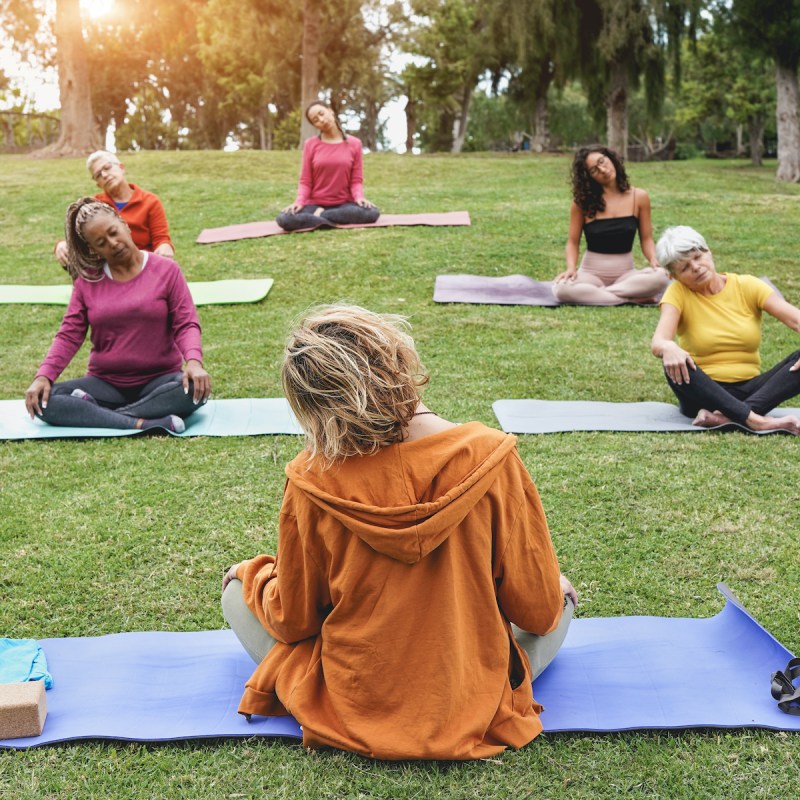
“Oh, my aching back!” Everyone has uttered those words a time or two, myself included. One day, though, I noticed that my back was always bothering me. There was no accident or injury, I was just having lots of pain. I took the usual route, starting with my family doctor, who referred me to a physical therapist. Did it help? I told myself that it did, but honestly, it probably didn’t.
Videos by TravelAwaits
For several years, the pain came and went. I found a good chiropractor, alternating between PT and chiropractic adjustments. Eventually, I had a couple of steroid injections for pain. The first one was effective, but the second was not (both were several hundred dollars).
Despite my discomfort and pain, I kept living a pretty normal life. I took care of my three kids, went to my teaching job every day, and exercised as often as I could. I figured that “getting strong” would alleviate my pain, and I tried to focus on strengthening my glutes and core. My efforts felt like they were in vain, though, as I never saw much improvement in my back. I powered through, like the tough Midwesterner that I am. With a family and a full-time job, I didn’t have time to deal with my back.
Fast forward a few months. It was a Sunday, and I was getting a pedicure with my adult daughter. The salon was very busy, and we sat waiting for what seemed like forever. Finally, we were done. As I awkwardly got up from the pedicure chair, I noticed it — something was different. This was no longer just discomfort, it was throbbing pain.
Shortly thereafter, I ended up in the spinal surgeon’s office for a consultation. Based on my x-rays and MRI, I was a good candidate for a TLIF (transforaminal lumbar interbody fusion). My surgeon showed me the evidence. My vertebrae had wandered out of alignment and my spine was slightly rotated, but I was still in disbelief. Huh? When did this happen? I didn’t fall… no car accident… huh?
My Hail Mary play was to see yet another physical therapist and hit those exercises hard all summer while I was not teaching. I did not want surgery.
Finally, with some real talk from my physical therapist, I accepted that surgery would have to be my next step. My life had become very small. Every day after teaching, I would hobble home to lay on my icepack, eat dinner, and lay down again until bedtime. I avoided going anywhere I would have to sit for any length of time, which eliminated any road trips, dinner invitations, concerts, etc.
Once we jumped through the hoops of insurance approval and the pre-surgery physical, I was all set. Unfortunately, my surgery would be in January because of the holiday — nevermind that I’d already met my deductible. At that point, I was just happy to be on the schedule.
My family celebrated the holiday, and with me often laying on my stomach, I got prepped for surgery. Everything went pretty well, considering how big the surgery was. My surgeon fused three of my vertebrae, inserted one titanium rod on either side of my spine, and secured everything with screws. I went home 3 days later with the “no BLT” (bending, lifting, twisting) directive stuck in my head.
Recovery has not been easy, and the first 6 weeks were by far the worst. As my surgeon warned me, I had lots of regret for the first 2 weeks. I was constipated, couldn’t sleep comfortably, and was still in lots of pain. As my husband kept emphasizing the long game, things gradually improved.
As of this writing, I’ve been healing for 6 months. So I’m completely healed, right? Well, let’s just say I’m “getting there.” Total recovery — will my back ever be perfect? No. — can take up to 18 months. As I continue to make progress, not in inches, but in millimeters, here are some strategies that have helped me in my recovery.
1. Exercise
We all know how important exercise is for overall good health. As someone who has been exercising for 30 years, I love a good workout. Unfortunately, I wouldn’t be doing a true “workout” anytime soon. It was almost like I didn’t just have surgery. Instead, I kind of had an entirely new spine. I had to learn how this new spine would work. For the first 6 weeks, I was limited to walking to the end of the driveway and doing my minimal rehab exercises.
Three months after the surgery, my doctor finally cleared me for activity. I was thrilled. Walking is one of my favorite pastimes, and I spend lots of time walking in our neighborhood and through local parks. After each session, however, I had to make sure to ice my back thoroughly.
I cautiously began to add weight lifting to my routine. I’m currently working with a personal trainer twice a week to get myself back into shape. I lost a lot of muscle both during my recovery and the year or so prior, when my activity was so limited. I gained about 15 pounds during this process, which I’m determined to lose as my muscle mass grows.
Besides being great for my physical recovery, exercise has been essential in my mental and emotional recovery. Many patients experience depression following a major surgery, and exercise is a key part of staying mentally fit.
2. Yoga
Why does yoga have its own category? Isn’t it just another form of exercise? Well, not exactly. While exercise (think cardio and weights) focuses on strengthening muscles, yoga focuses more on stretching, as well as mindfulness. Stretching, and I cannot emphasize this enough, is critical to recovery from back surgery. Think about it.
When I began this journey, my vertebrae were a bunch of anarchists and my spine was all over the place. Post-surgery, I suddenly had two titanium rods in my back. So I went from being very loose to being extremely rigid and tight. And then I essentially didn’t move for 6 weeks. My son even had to help me with my socks.
Stretching is part of every type of yoga, whether it’s Vinyasa, Ashtanga, Yin, or something else. Restorative yoga, though, is unique. This style of yoga activates the parasympathetic nervous system, encouraging relaxation and reducing stress. Restorative yoga has been shown to improve quality of life for those with chronic health conditions (back pain, fibromyalgia, rheumatoid arthritis, etc.).
As I continue to heal, I’m enjoying trying different styles of yoga. So far, I’ve done Restorative, Yin, and Ashtanga. Yoga has been so beneficial for me — and my body, mind, and spirit — that I’m actually considering a yoga retreat sometime soon!
3. Meditation
Another well-known strategy for maintaining a healthy mental attitude is meditation. I’ve been dabbling in meditation for a few years, so this was not new information to me.
There are several meditation apps, including Headspace (varying subscription plans available), Insight Timer (free and paid versions), Calm (monthly, annual, and lifetime subscriptions available), and more. One app that is different from the others is Curable (monthly and annual plans). This app uses meditation, visualization, and education to address chronic pain in hopes of reorienting your brain. I’ve used all four of these apps throughout my recovery, and found each to be helpful.
I really enjoy the coaching aspect of Curable, which takes you through different exercises when you’re having pain. There’s even an “emergency” button of sorts that leads you through a visual breathing exercise, calming you down. I found the other three apps to be quite similar to one another, with only slightly different bells and whistles.
4. Massage
Many individuals count massage as part of their wellness routine. Although a massage can be expensive, the physical and emotional results can be worth it. There are a variety of different kinds of massages, including Swedish, Shiatsu, Myofascial, and others. Finding a practitioner whose massage style suits you may take some time, as some may use a touch that’s too light, while others may leave you feeling too sore. It’s worth the trouble to look around, but make certain to communicate your needs to your massage therapist before giving up. A quality massage therapist wants to meet your needs, and will respond well to feedback and suggestions.
5. Lowering My Expectations
I am not in my 20s, 30s, or even 40s anymore. I have always been a productive, achievement-oriented person, seeking results right away. Whether a result of aging, maturing, back surgery, or something else, I’m not sure, but I definitely embrace the notion that, at the age of 54, I have nothing to prove to anyone.
Triathlons are not in my future, but being in good shape absolutely is. I’ve used these strategies to get just a little stronger every day, and have learned to accept my body for what it can do. Even on days when my pain makes an appearance, I’m having a fantastic time designing just the right life for myself.
For more inspirational stories from our travel writers, check out our inspire category:
